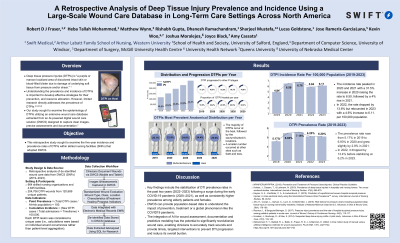Clinical Research
(CR-026) Trends in Deep Tissue Injury Prevalence and Incidence Leveraging Digital Wound Care Solutions Data in Skilled Nursing Facilities (2019-2023): A Retrospective Study
Friday, May 2, 2025
7:45 PM - 8:45 PM East Coast USA Time

Heba Tallah Mohammed, PhD; Lucas Goldstone, BA, MSc – Swift Medical Inc.; Amy Cassata, BSN, RN, WCC
Introduction: The increasing prevalence of deep tissue injuries (DTIs) has put a significant strain on healthcare systems, especially in long-term care settings where vulnerable populations are at a higher risk.1 DTIs are different from other pressure injuries (PIs) by developing internally, often originating in muscle tissue beneath intact skin, which makes early detection challenging and can lead to severe complications such as infection, immobility, and increased mortality.1 In response, healthcare providers have prioritized DTI prevention, and skilled nursing facilities (SNFs) now consider effective DTI prevention a crucial quality measure.2 Digital Wound Care Solutions (DWCS) offer advanced capabilities for early detection, and documentation of wounds, providing opportunities to enhance wound outcomes.3 This study examined trends in DTI prevalence and incidence in SNFs that implemented DWCS from 2019 to 2023.
Methods: A retrospective analysis was conducted leveraging the DWCS dataset from 4,053 SNFs. Data were extracted using Structured Query Language (SQL) and categorized by patient demographics such as age and sex. Admission data was also collected. Chi-squared tests with pairwise comparisons and post-hoc Bonferroni correction assessed associations between patient characteristics and DTI distribution. The dataset comprised 204,706 unique DTI evaluations from 120,689 patients, all documented through DWCS.
Results: Annual DTI prevalence ranged from 5.17% in 2019 to 7.16% in 2021, stabilizing at 6.2% in 2022 and 2023. Older patients (aged 81-90 years) and females exhibited higher DTI rates. Cumulative incidence increased from 4.94 per 100,000 in 2019 to 6.76 in 2021, then decreased in 2022, with a slight rebound to 6.11 in 2023.
Discussion: The surge in DTI incidence during 2020-2021 likely reflects healthcare strain during COVID-19, while stabilization in 2022-2023 suggests improved prevention efforts. These results highlight the importance of digital tools in monitoring DTIs, underscoring the necessity for further research to optimize the technology.
Methods: A retrospective analysis was conducted leveraging the DWCS dataset from 4,053 SNFs. Data were extracted using Structured Query Language (SQL) and categorized by patient demographics such as age and sex. Admission data was also collected. Chi-squared tests with pairwise comparisons and post-hoc Bonferroni correction assessed associations between patient characteristics and DTI distribution. The dataset comprised 204,706 unique DTI evaluations from 120,689 patients, all documented through DWCS.
Results: Annual DTI prevalence ranged from 5.17% in 2019 to 7.16% in 2021, stabilizing at 6.2% in 2022 and 2023. Older patients (aged 81-90 years) and females exhibited higher DTI rates. Cumulative incidence increased from 4.94 per 100,000 in 2019 to 6.76 in 2021, then decreased in 2022, with a slight rebound to 6.11 in 2023.
Discussion: The surge in DTI incidence during 2020-2021 likely reflects healthcare strain during COVID-19, while stabilization in 2022-2023 suggests improved prevention efforts. These results highlight the importance of digital tools in monitoring DTIs, underscoring the necessity for further research to optimize the technology.

.jpg)